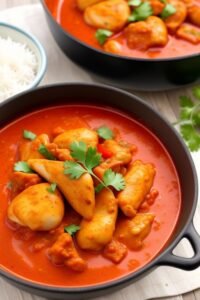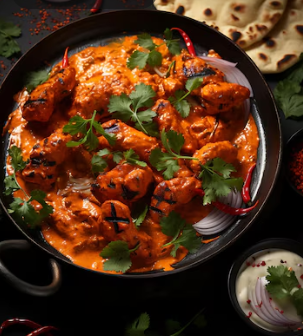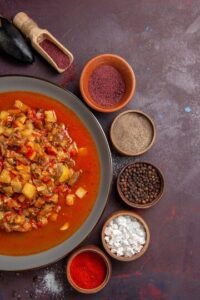Introduction to Chicken Masala
Overview of Chicken Masala
Is chicken masala spicy? Chicken Masala is a beloved dish in Indian cuisine, featuring roasted chicken in a creamy, spiced tomato sauce. While its exact origins are debated, it’s recognized globally for its deep flavors and adaptability in spice levels. This dish exemplifies the rich culinary traditions of the Indian subcontinent and has been embraced by various cultures worldwide.
Popularity in Different Cuisines
Globally, Chicken Masala has adapted to various culinary traditions, particularly in the UK where it’s considered almost a national dish. Restaurants across North America, Europe, and Australia offer localized versions, incorporating regional ingredients and techniques. This widespread popularity underscores its versatility and the global influence of Indian cuisine, making Chicken Masala a prime example of cultural culinary fusion.
Understanding Spiciness in Chicken Masala
Definition of Spiciness
Spiciness in cuisine refers to the heat or pungency experienced while eating foods that contain spices or spicy ingredients. This sensation is primarily caused by capsaicin, found in various types of chili peppers, which activates heat receptors in the mouth. The degree of spiciness is often measured on the Scoville scale, which assesses the amount of capsaicin present. In dishes like Chicken Masala, spiciness can range from mild to intensely hot, affecting both the flavor profile and the dish’s overall appeal.
Ingredients Contributing to Spiciness
Chicken Masala gets its spiciness from a blend of ingredients known for their heat levels. Commonly used spicy ingredients include:
- Red chili powder: Provides vibrant color and sharp heat.
- Green chilies: Offer a fresh, piercing heat.
- Black pepper: Adds a subtle, earthy spiciness.
- Ginger: Contributes a sharp, pungent warmth.
- Garam masala: A blend that can include hot spices like cloves and black pepper.
- Cumin: Gives a smoky note, which can enhance the perception of heat.
- Cayenne pepper: Often added for an extra kick, significantly increasing the dish’s heat level.
These ingredients are used in varying proportions to achieve the desired spiciness, tailored to different palates and regional preferences.
How Spiciness is Adjusted
Chefs adjust the spiciness of Chicken Masala by modifying the type and amount of chili peppers and spice blends used. For a milder version, chefs might use less chili powder or opt for milder spices like paprika instead of cayenne. Additionally, increasing the amount of dairy, such as cream or yogurt, in the masala sauce can temper the heat, as dairy products help neutralize capsaicin’s effect on the taste buds. On the other hand, for a spicier dish, more green chilies or extra black pepper might be added. Understanding and manipulating these elements allows chefs to customize the dish’s heat level according to customer preferences or regional taste profiles.

Cooking Chicken Masala
Traditional Recipe Overview
Is chicken masala spicy? The traditional method of preparing Chicken Masala involves marinating chicken pieces in a mixture of yogurt and spices such as turmeric, garam masala, cumin, and chili powder. The marinated chicken is then grilled or roasted to develop a rich flavor and charred texture. For the masala sauce, onions, garlic, and ginger are sautéed until golden, then tomatoes, chili peppers, and additional spices are added and cooked down into a thick, flavorful base. The grilled chicken is added to this sauce and simmered until tender. Cream or coconut milk is often stirred in towards the end to create a creamy consistency and temper the spiciness, resulting in a harmonious blend of flavors that is both aromatic and deeply satisfying.
Variations in Recipes
Regional variations of Chicken Masala can significantly impact the spiciness of the dish. For example, in Northern India, the use of heavy cream and butter tends to make the dish milder and richer. Southern Indian versions might include curry leaves and mustard seeds, offering a sharper and more aromatic heat. In the UK, where Chicken Masala is extremely popular, the recipe is often adapted to suit a less spicy palate, with the addition of more tomatoes and cream. Conversely, in regions like Kerala or Tamil Nadu, a higher quantity of black pepper and red chili may be used, giving the dish a more intense heat. These regional adaptations not only showcase the versatility of Chicken Masala but also highlight how local ingredients and taste preferences influence the fundamental aspects of the dish.
DIY Tips for Adjusting Spiciness at Home
Adjusting the spiciness of Chicken Masala at home is straightforward:
- To increase spiciness: Add more green chilies, red chili powder, or a pinch of cayenne pepper. Experimenting with different types of chili can also vary the heat and flavor profile.
- To decrease spiciness: Incorporate more dairy products like cream, yogurt, or even coconut milk, which help mitigate the heat. Alternatively, increase the amount of tomatoes or onions in the masala to dilute the spiciness without compromising the sauce’s rich texture and flavor.
- Balancing flavors: Ensure to balance the spiciness with acidic components like lemon juice or a dash of vinegar to enhance the depth of flavors in the masala.
These tips allow cooks to tailor Chicken Masala to their specific taste preferences, making it a truly personal and customizable dish.
Consumer Perception and Culinary Practices
How Spicy is Chicken Masala Traditionally?
Chicken Masala’s traditional spiciness varies by region. In Northern India, the dish is milder due to the use of cream and yogurt, while Southern India’s version is notably hotter, utilizing more tamarind and red chilies. In the West, particularly the UK, it is commonly prepared with moderate spice to appeal to a broader audience. These variations reflect both local culinary preferences and the broader adaptation of the dish globally.
Cultural Variations in Spice Tolerance
Spice tolerance differs significantly across cultures, influencing the preparation of Chicken Masala. Western palates often prefer milder versions of the dish, while in many Asian countries, higher spice levels are not only tolerated but preferred. This cultural disparity affects how Chicken Masala is marketed and adjusted in restaurants worldwide, often with customizable spice levels in India, and fixed, milder options in the West. Understanding these preferences is essential for those serving or enjoying Chicken Masala across different cultural settings.
Part 7: Health and Nutritional Aspects of Chicken Masala
Nutritional Components of Chicken Masala
- Protein Source: Chicken, the primary ingredient, is a great source of lean protein, essential for muscle repair and growth.
- Antioxidants: Spices like turmeric and cumin are rich in antioxidants, which combat oxidative stress and may reduce the risk of chronic diseases.
- Dietary Fibers: Onions and tomatoes add necessary dietary fibers, promoting digestive health and contributing to a feeling of fullness.
- Anti-inflammatory Properties: Many spices used in Chicken Masala, such as ginger and garlic, offer anti-inflammatory benefits, which can help reduce the risk of health issues like arthritis and heart disease.
Health Considerations of Spicy Foods
- Metabolic Benefits: Capsaicin, found in chilies, can enhance metabolic rate, aiding in weight loss and fat burning.
- Digestive Health: Moderate amounts of spicy ingredients may improve digestion by increasing stomach secretions.
- Risks for Sensitive Individuals: For those with sensitive stomachs or conditions like acid reflux, high levels of spiciness might lead to discomfort or exacerbate symptoms.
- Balanced Consumption: Understanding personal tolerance to spice is crucial; moderate consumption can be beneficial, but excess may lead to health issues.
Modifying Chicken Masala for Dietary Needs
- Reducing Fat: Substitute heavy cream with yogurt or light coconut milk to lower the fat content without sacrificing creaminess.
- Dairy-Free Version: Use coconut milk instead of cream to cater to lactose-intolerant or vegan diets.
- Low-Sodium Options: Opt for fresh tomatoes and limit added salt. Use herbs and spices to enhance flavor without increasing sodium content.
- Ketogenic Adaptation: Focus on increasing the fat content by adding more oil and using full-fat coconut milk while ensuring that all other ingredients are low in carbohydrates.
- Gluten-Free Considerations: Ensure that all spice blends used are free from additives that may contain gluten.
Part 8: The Role of Spices in Chicken Masala
Historical Significance of Spices
- Turmeric: Originally from South Asia, turmeric has been used for thousands of years, not only in cooking but also in Ayurvedic medicine due to its anti-inflammatory properties.
- Cumin: With origins tracing back to ancient Egypt, cumin was highly valued for both its culinary and medicinal qualities. It was used in mummification and was believed to aid digestion.
- Coriander: Native to the Mediterranean and Middle Eastern regions, coriander was cultivated by ancient Egyptians and Greeks. It has been used in cooking and as a medicinal herb, historically believed to be a remedy for illnesses.
- Global Trade: These spices were among the most sought after in the spice trade, significantly influencing cuisines and economies worldwide. Their journey across continents showcases the interconnectedness of different cultures through culinary practices.
Modern Culinary Uses of Key Spices
- Turmeric in Modern Cuisine: Beyond traditional curries, turmeric is now a star in health-focused dishes like golden milk lattes and anti-inflammatory smoothies.
- Cumin’s Contemporary Appeal: Cumin’s warm, earthy flavor has found a place in Tex-Mex dishes, Moroccan tagines, and even in artisanal breads.
- Coriander’s Versatility: Coriander seeds and fresh leaves (cilantro) are prevalent in Latin American salsas, Middle Eastern salads, and Chinese stir-fries.
- Fusion and Innovation: Chefs worldwide experiment with these spices in unexpected ways, such as turmeric in desserts, cumin in cocktails, and coriander in craft beers. This creative use highlights the spices’ adaptability and enduring appeal across various culinary landscapes.
This exploration into the spices integral to Chicken Masala not only educates about their origins and historical uses but also illustrates their significant impact on modern global cuisine, emphasizing their timeless relevance in the culinary world.
FAQs About Chicken Masala and Spiciness
Is Chicken Masala Considered a Spicy Dish?
Chicken Masala can range from mildly spicy to very hot, depending on the recipe and region. Traditionally, the dish includes a blend of spices that can give it a noticeable heat. However, the level of spiciness is often adjusted to suit different palates, especially outside of South Asia where it might be served milder to cater to local taste preferences.
Can I Make Chicken Masala Less Spicy?
Yes, you can easily adjust the spiciness of Chicken Masala. To reduce heat, use milder chili powders, fewer green chilies, or increase the amount of cream or yogurt in the recipe. These ingredients help balance the heat while maintaining the dish’s flavorful essence.
What Makes Chicken Masala Spicy?
The spiciness in Chicken Masala typically comes from ingredients like red chili powder, green chilies, and black pepper. The use of garam masala, which can include spices like cloves and cinnamon, also contributes to its heat. Each of these ingredients can be adjusted to increase or decrease the spiciness of the dish according to taste preferences.
How Can I Tell if Chicken Masala Will Be Too Spicy for Me?
To gauge if Chicken Masala might be too spicy, consider the ingredients listed, particularly the type and amount of chilies used. When ordering in a restaurant, ask about the dish’s spice level and whether it can be adjusted. If cooking at home, start with smaller amounts of spicy ingredients and adjust based on taste. This way, you can customize the heat level to ensure it’s enjoyable and suitable for your spice tolerance.
Recommended Internal Links
-
-
- Link: What is Chicken Marsala Sauce Made Of?
- Embed on Phrase: « Masala sauce » in the section where you discuss the ingredients contributing to spiciness.
- Link: Chicken Marsala Fettuccine
- Embed on Phrase: « Chicken Masala » in the introduction when mentioning variations of the dish.
- Link: What is Traditionally Served with Chicken Marsala?
- Link: What is Chicken Marsala Sauce Made Of?
-
-
-
-
- Embed on Phrase: « serve with Chicken Masala » in the section on Serving and Pairing Chicken Masala.
-
-


